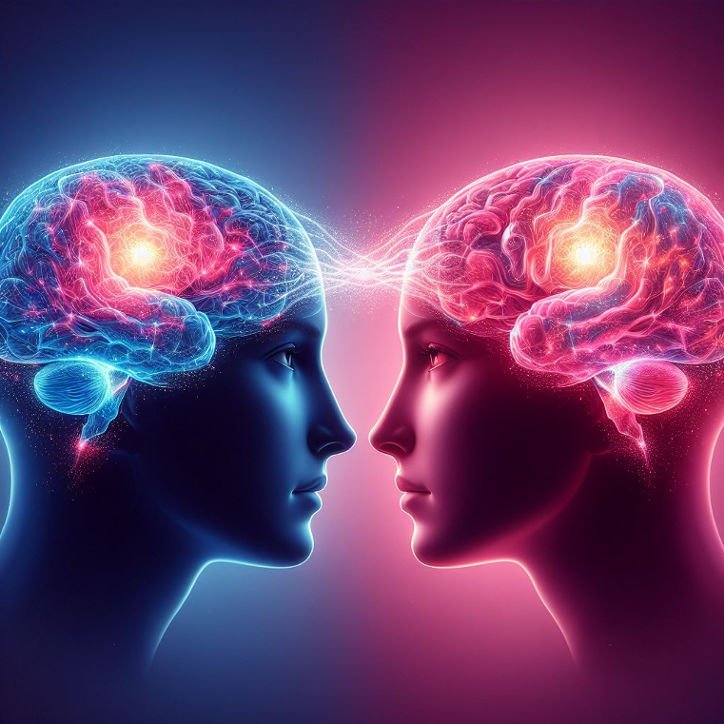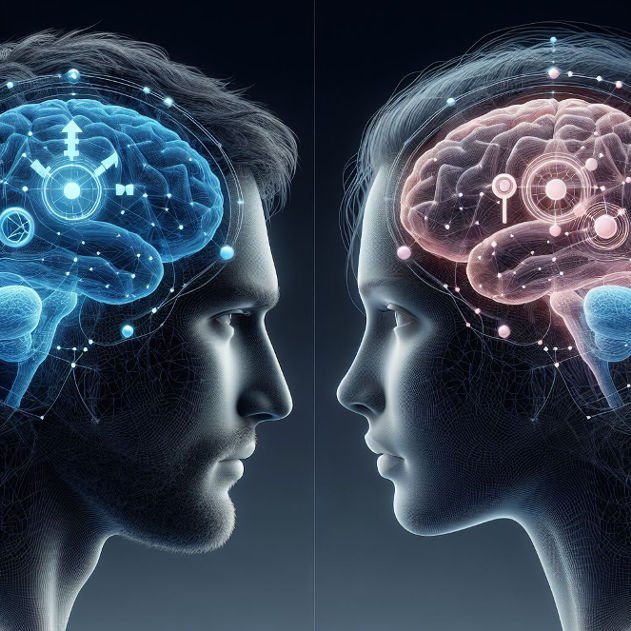The findings of a study published in February 2024 by a team of Stanford University experts provide new light on the contentious issue of whether male and female brains are different. According to the study’s authors, AI-generated brain scans show that males and girls are wired differently and that cognitive ability differences exist. However, the scientific community is divided on the subject, with some academics warning against the spread of a “hunt the sex differences” mentality.
1) Do men and women have different wiring?
For millennia, people have debated whether men and women are wired differently. But do men and women have distinct brains?
2) Neurosexism
For millennia, people have debated whether men and women are wired differently. But do men’s and women’s brains differ?
3) The link between brain anatomy and behavior.
According to a 2021 study published by the National Center for Biotechnology Information (NCBI), men and women differ in brain shape and behavior, highlighting the possibility of a relationship between gender differences in brain and behavior.
4) A tenuous connection
The study, however, discovered only a minor connection between brain size and behavioral differences.
5) The brain: is it gendered?
Furthermore, the underlying causes of average variations in male and female behavior, such as distinct cognitive ability and personality traits, are poorly understood and remain subject to interpretation. Is the brain gendered, though, is still an open topic.
6) Is the person male or female?
A Stanford University study group’s article, released in February 2024, suggests that it is.
7) AI-driven study
The researchers examined brain scans with an artificial intelligence (AI) neural network model to determine if it could “reliably” and “robustly” distinguish between female and male brains.
8) Can the answer be found by an algorithm?
The goal was to see if the algorithm could distinguish whether the brain patterns being examined were from women or men. It could, was the response.
9) Can an algorithm find the answer?
The goal was to see if the algorithm could distinguish whether the brain patterns examined were from males or women. The answer was yes, it could.
10) Regional variations
Brain scans revealed differences in the regions of the brain that control specific functions.
11) Identifying the function of the brain

The majority of these differences occur in the default mode network (the area of the brain where we store key elements of social knowledge acquired through interaction), as well as the striatum and limbic network—areas involved in a variety of processes such as daydreaming, remembering the past, planning for the future, making decisions, and smelling.
12) Results released to the public
The findings were published in the Proceedings of the National Academy of Sciences (PNAS) and reported by a variety of media sites.
13) An additional puzzle piece
According to the Stanford team, these findings have effectively contributed another piece to the puzzle. They believe their findings lend credibility to the hypothesis that biological sex alters the brain. But not everyone is convinced.
14) A contentious issue
The search for a male and a ‘female’ brain is not new. But many disagree with this contentious issue.
15) Getting to the truth
According to the scientific journal Nature, “the history of sex-difference research is rife with innumeracy, misinterpretation, publication bias, weak statistical power, inadequate controls, and worse.”
16) Past prejudice
Indeed, neurosexism has persisted since the nineteenth century. Next, on the pretext of supposed anatomical differences between the male and female brains, scientists and philosophers swiftly concluded that women were mentally inferior or incapable of doing specific activities. In 1931, a woman is depicted seated with a psychograph, or phrenology machine, on her head.
17) A “missing five ounces”
However, early studies into skull capacity measures revealed that men’s brains were, on average, larger and heavier than women’s. On this basis, several critics advanced the so-called “missing five ounces” argument, which they claimed was fundamental to men’s alleged greater talents.
18) Greater size of body and brain
Notes New Scientist, the simple explanation is that bigger bodies require more brain tissue to run them—a relationship seen across animal species.
19) Advancing the agenda of “sex differences”
While refusing to conclude the importance or meaning of the differences discovered by the Stanford researchers, neuroscientist Gina Rippon advised in The Guardian against fostering a “hunt the sex differences” agenda.
20) Looking for sex-specific changes in the brain
“There appears to be an implacable need, even in today’s world, to find a nice set of biologically programmed, sex-specific differences in the brain, and agree that these must be the basis of any female-male differences in behavior, temperament, or ability and achievement,” argued Rippon, an emeritus professor of cognitive neuroimaging at Aston Brain Centre at Aston University in England.
FAQs
Is there a difference between men’s and women’s brains?
Yes, there are some minor differences between men’s and women’s brains, but overall, they are much more similar than different. Here’s a breakdown:
- Size: The biggest difference is size. Men’s brains tend to be about 10% larger than women’s. However, this doesn’t necessarily mean men are smarter. Brain size is relative to body size, and women’s brains are just as efficient.
- Structure: There are some regional variations. The part of the brain linked to spatial skills, the inferior parietal lobule, is often larger in men. Areas associated with emotion and memory may be larger in women, but research on this is ongoing.
- Connectivity: Studies suggest women may have stronger connections between the two hemispheres of the brain, while men’s connections might be stronger within hemispheres. This could explain differences in communication and processing of information.
It’s important to note that these are averages, and there’s a lot of overlap between men’s and women’s brains. More importantly, these minor variations don’t translate to clear-cut behavioral differences. People’s experiences and environment play a much bigger role in shaping their abilities.
How do boys’ brains differ from girls?
The differences between boys’ and girls’ brains are subtle, and much like adults, the similarities are far greater. Here’s a breakdown of what we know:
- Size: On average, boys’ brains are larger than girls’ brains by about 10-15%. But, just like with adults, this doesn’t mean boys are smarter. Brain size is relative to body size.
- Development: There may be slight differences in how different brain regions develop. Girls tend to have a developmental advantage in language areas, while boys’ spatial reasoning areas might mature a bit slower.
- Structure: Some brain regions show minor size differences. Boys may have a larger amygdala, involved in processing emotions, while girls might have a larger corpus callosum, which connects the brain hemispheres.
Important Caveats:
- These are averages, there’s a lot of overlap between boys and girls.
- These slight variations likely don’t lead to strict behavioral differences.
- Environment and experiences play a much bigger role in shaping a child’s strengths and weaknesses.
So, while there are some minor distinctions, boys’ and girls’ brains are fundamentally similar.
Who thinks more logically male or female?
There’s no scientific basis to say one gender thinks more logically than the other.
Here’s why:
- Brain Sex Differences are Subtle: While there are some structural and functional variations in brains between men and women, they are minor.
- Logic is Multifaceted: Logical thinking involves analyzing information, identifying patterns, and drawing reasonable conclusions. Different brain regions contribute to this, and both men’s and women’s brains have these regions.
- Greater Similarities: Overall, brain structure and function are more similar between men and women than different.
What about stereotypes?
The idea of men being more logical and women more emotional is a stereotype. People of all genders can be logical and emotional.
What matters more?
A person’s experiences, environment, and individual strengths all influence how they approach problems and think. These factors have a much bigger impact on someone’s thinking style than their gender.
Which side of the brain do females use?
Females, like males, use both sides of their brains!
The idea that one brain side dominates in a specific gender is a misconception. Here’s a breakdown:
- Brain Hemisphere Function: The left brain is typically associated with logic and language, while the right brain is linked to creativity and spatial reasoning.
- Both Sides Work Together: In reality, both hemispheres communicate and work together for most tasks.
- Possible Differences: Some research suggests females may have stronger connections between the hemispheres, allowing for more integrated processing of information.
However, this is an ongoing area of study, and individual differences are significant.
Overall, regardless of gender, our brains are complex and use both sides for a variety of functions.

I’m a seasoned content creator with 6+ years of experience crafting engaging, SEO-optimized content that drives traffic and rankings. I excel in keyword research, link building, and guest posting, ensuring your brand reaches new heights.

